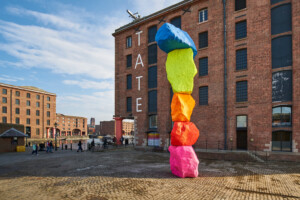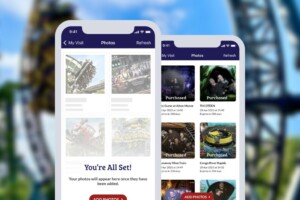By Jonathan Katz, executive producer, “Altered State”
The exhibit has been very well received by the public and garnered a critical writeup in the Los Angeles Times (A Museum That Shouts Climate Change) and quite a bit of coverage in the industry media as well.
Defining an interactive as a venue with a screen is limiting, and most often puts the museum at a comparative disadvantage. Although “Altered State” contains several high-tech interactives of which we are very proud, “Share Your Ideas, ” one of the outstanding successes, is decidedly low-tech, involving little more than paper and pencil. It’s located at the center of “Altered State, ” within the Arena for Engagement where the content focuses on communities, families and individuals, so it was an obvious site to invite folks to contribute to the exhibit.
In this simplest and most direct of interfaces, visitors write and sketch their own suggestions and ideas for conserving energy, reducing carbon footprint and combating climate change. Pencils and slips of paper about the size of luggage tags are supplied by the Academy for this purpose. Visitors hang their completed entries on hooks for others to view. People respond to the succinct format: each individual entry has the feeling of a work of art.
This community outpouring of messages on a vital topic that touches us all has been so successful that the museum has had to work to keep up the supply of pencils and paper. In search of a sustainable source for the tags, the Academy’s creative services department recruited their printer, Paragraphics, to cut them from make-readies (paper that has been test-printed on one side).
Interactives in the built environment should be literally active, having some quality of physicality. Visitors have to move their arms, their legs, their bodies, and their minds. The idea for “Share Your Ideas” arose from conversations with our lead exhibit developer Darcie Fohrmam, Emily Routman and myself. We had been looking for simple and direct ways for visitors to contribute content, and had noticed lots of informal efforts at other museums, i.e. sticky notes on foamcore, to let visitors leave messages and comments. We wanted people to see their work in its rightful place, so the design of hooks in rows was used to make the display self organizing, yet give each contributor the freedom to choose where on the board to place their tag.
The simple act of writing and mounting the tag for others to see is a meaningful experience for the visitor. But the tags themselves – already numbering in the tens of thousands – will also go on to help spread the word in various ways. Some will be scanned and posted on the Academy website. Others will be used to aid classroom projects. The tags are being saved by Carol Tang, director, visitor interpretive programs for the Academy, as the basis for a research paper (educators interested in obtaining access to the tags can email Ms. Tang: [email protected]). This prolific outpouring will not go unheard.
Photos: Joe Fletcher
See also:
Eco-friendly Immersive Theater Launched at New California Academy of Sciences
Rana Creek Raises the Roof on the California Academy of Sciences
At the New California Academy of Sciences, Cinnabar’s Climate Change Exhibits Speak Up About State’s Environment and Future








